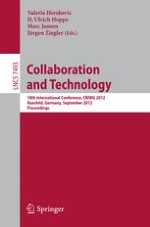2012 | Buch
Collaboration and Technology
18th International Conference, CRIWG 2012 Raesfeld, Germany, September 16-19, 2012 Proceedings
herausgegeben von: Valeria Herskovic, H. Ulrich Hoppe, Marc Jansen, Jürgen Ziegler
Verlag: Springer Berlin Heidelberg
Buchreihe : Lecture Notes in Computer Science
